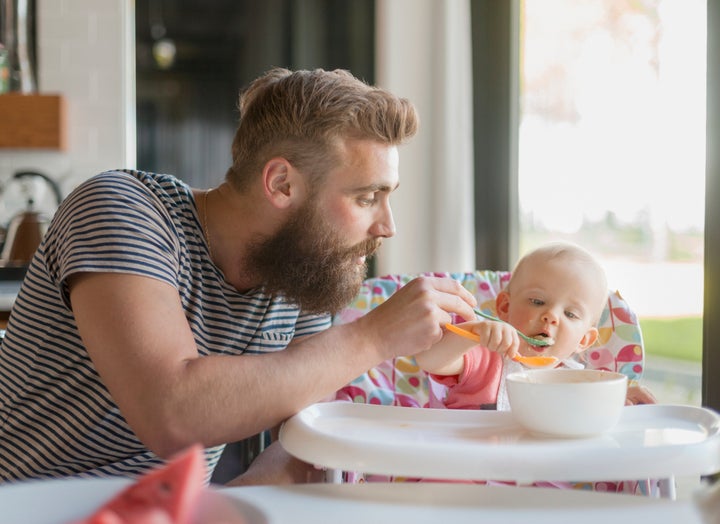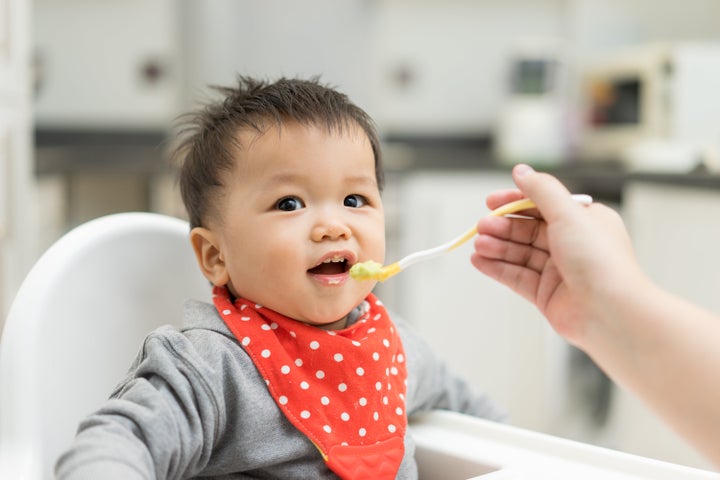
Once babies are about four to six months old, they stop subsisting on solely breast milk or formula and move on to real food. So, what are you supposed to feed them?
If homemade baby food isn’t your jam, that’s totally understandable. Not every parent has the time to devote to straining their own peas, or the freezer space to store a ton of teeny little jars. That’s fully valid.
But if it’s something you have the time, the storage, and the will to put off, making your own baby food can save you money, and is generally a healthier option than feeding your kid store-bought food. And it’s relatively easy to make, too. (Although fair warning: it can be very time consuming. Peeling, cutting, spicing, and roasting a sweet potato doesn’t take 10 minutes!)
Watch: Report finds many baby foods contain metals. Story continues after video.
Here are some tips for parents getting started in the world of homemade baby food.
Opt for smooth, healthy, mild foods
Cooking Light suggests purees that are smooth and mild, like sweet potatoes, squash, green peas, avocado, and carrots. Fruits like apples, pears, plums, peaches, cantaloupe, and bananas can work, too.
Tasty suggests starting with simple single-ingredient foods for really young kids. Once you know your baby likes eating a certain food, you can try changing things up by adding another fruit or vegetable to this mix.
Proteins shouldn’t be introduced until babies reach the seven- to eight-month mark.
Once a baby is about nine months old, they can probably handle chunkier textures and more complex combinations, according to Healthline. But check with your doctor or pediatrician first before you start giving your baby chunky purees and whole foods.
Start small with foods that can cause gas
Beans, broccoli, cauliflower, onion, and garlic can cause gas which can upset a baby’s stomach, so it’s best to serve small amounts to see how they react to these foods. If they don’t get bad gas, it’s fine to continue giving them.
Beans, for example, are rich in iron, and make an excellent first food for babies (pureed to start, and then whole around nine months), especially those who are being raised vegetarian.
Avoid honey
It can cause botulism in infants under one.
Be on the lookout for allergies
Milk, eggs, peanuts, and wheat are common allergens, so be careful about how you introduce them and make sure to monitor your baby for signs of a reaction. Some organizations suggest spacing the introduction of new foods a few days apart, so you can easily monitor reactions.

Invest in a blender or food processor
If you happen to be a fancy food type, you can look into gadgets like baby food makers. But any variety of a simple blender or food processor will also do the trick just fine.
Cook safely
There are a few simple steps you can take to make sure the food you’re making is tasty, healthy, and safe for your baby.
1. Thoroughly wash your fruit or vegetables, and peel them if necessary.
2. Bake, steam, or roast the food. WebMD suggests steaming or microwaving, as those options preserve the most nutrients. However, if you microwave a food, be sure to test it for hot spots, as it’s often heated unevenly, and always microwave the food on a plate, not in a jar. Click here for more information on microwaving baby food safely.
3. Mash, blend, or purée the food. You can consider adding a little water, breast milk, or formula to help this process along.
Remember to store safely
Store-bought food can be stored in the cupboard at room temperature because it hasn’t been exposed to air yet. But to safely store cooked food, it needs to be kept in an airtight container in a fridge for up to two days, or else frozen for up to three months. For easy freezer storage, you can scoop it into ice cube trays, “splat” it onto wax-lined cookie sheets, or keep it in freezer-safe containers or bags.

Recipe ideas
Again, you usually want to stick to single-ingredient purées until your baby is about seven months old, and not introduce combinations that are too chunky until about nine months. But since all babies develop at a different rate, your doctor or pediatrician may tell you otherwise.
For a seven- to eight-month old:
- Pumpkin and thyme (from Baby Foodie)
- Spinach with white yams (from Smitten Kitchen)
- Potato, leek and pea (from Annabel Karmel)
- Apple, carrot and sweet potato (from Baby Foodie)
- Apple and blueberry (from Just a Pinch)
- Butternut squash and pear (from Annabel Karmel)
- Banana, blueberry and avocado (from Baby Foodie)
For a nine- to 12-month old:
- Baby beef stew (from Weelicious)
- Strawberry, spinach and barley purée (from Baby Foodie)
- Creamy provencal chicken for babies (from Bites for Foodies)
- Chunky veggie pasta for babies and toddlers (from Baby Foodie)
Good luck, and happy puréeing.
Also on HuffPost: